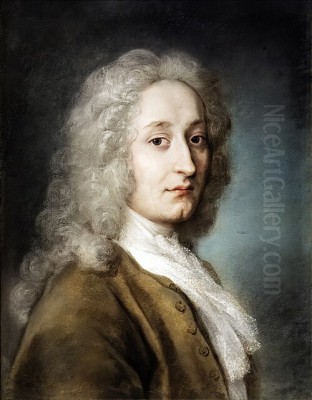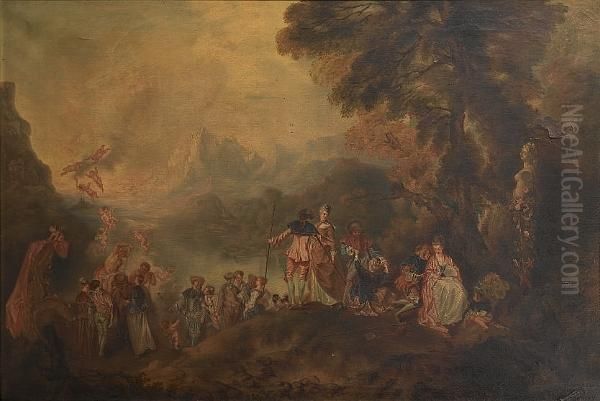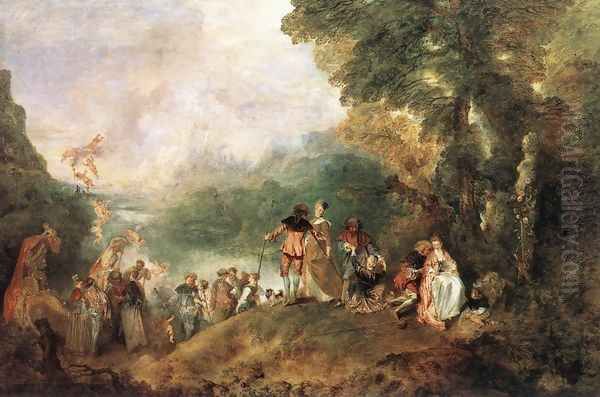
Jean-Antoine Watteau stands as a pivotal figure in the history of European art, an artist whose brief life belied the profound and lasting impact of his work. Primarily active during the Régence period in early 18th-century France, Watteau is celebrated as a principal founder and the most poignant interpreter of the Rococo style. Born in the Flemish town of Valenciennes in 1684, which had recently become part of France, his art synthesized the rich painterly traditions of the Low Countries with the burgeoning elegance and lightness of French taste. He captured the subtleties of human emotion and the fleeting nature of pleasure with a unique blend of grace, theatricality, and an underlying current of melancholy, inventing a new genre, the fête galante, which would define an era.
Early Life and Artistic Formation
Jean-Antoine Watteau's origins were modest. Born in Valenciennes, his father was a tiler or roofer, and his mother a washerwoman. Despite this humble background, his artistic inclinations were apparent early on. His initial training in Valenciennes was under Jacques-Albert Gérin, a local painter whose skills were reportedly limited. Recognizing the need for more sophisticated instruction and greater opportunities, the young Watteau made his way to Paris around 1702.
Life in Paris was initially challenging. He found work with a painter near the Pont Notre-Dame, essentially copying and mass-producing popular genre scenes and religious pictures for a pittance. This period of drudgery, however, exposed him to the Parisian art market and likely honed his technical facility. A significant step came when he entered the studio of Claude Gillot around 1704-1705. Gillot was a distinctive artist, known for his drawings, engravings, and paintings often depicting scenes from the theatre, particularly the Italian Commedia dell'arte.

Under Gillot, Watteau's artistic horizons expanded considerably. He absorbed Gillot's interest in theatrical subjects, costumes, and the expressive potential of gesture and pose. The characters of the Commedia dell'arte – Harlequin, Pierrot (or Gilles), Columbine, Mezzetin – began to populate his imagination and would become recurring motifs throughout his career. This immersion in the world of theatre provided him with a rich vocabulary for exploring human relationships and emotions in a visually captivating manner.
The Influence of Rubens and Decorative Painting
After leaving Gillot's studio around 1707-1708, Watteau found employment with Claude Audran III. Audran was not only a prominent designer and decorative painter but also the curator of the Palais du Luxembourg. This position was crucial for Watteau's development. Audran specialized in arabesques and grotesques, decorative styles that emphasized flowing lines, fantasy, and intricate ornamentation, elements that resonated with Watteau's own developing sensibility for elegance and lightness.
More importantly, working at the Luxembourg Palace gave Watteau direct and privileged access to Peter Paul Rubens's magnificent Marie de' Medici cycle. Studying these large-scale, dynamic Baroque masterpieces was a revelation. Watteau was deeply impressed by Rubens's vibrant color, fluid brushwork, and energetic compositions. While Watteau's temperament and scale were vastly different from the Flemish master's, the influence of Rubens is evident in Watteau's rich chromatic harmonies, his painterly technique, and his appreciation for the sensuous qualities of paint. He absorbed Rubens's lessons but translated them into a more intimate, delicate, and distinctly French idiom.
During this period, Watteau also competed for the prestigious Prix de Rome in 1709, winning only second prize. Disappointed, he briefly returned to Valenciennes, where he painted several military scenes, perhaps reflecting the town's status as a garrison city recently affected by the War of the Spanish Succession. These works show his growing skill in depicting figures in landscape settings and handling complex groupings.
The Birth of the Fête Galante
Upon his return to Paris, Watteau began to synthesize his diverse influences – the theatricality learned from Gillot, the decorative elegance from Audran, the painterly richness from Rubens, and his own innate sensitivity – into something entirely new. He started creating small paintings depicting elegantly dressed figures in idyllic parkland settings, engaged in conversation, music-making, flirtation, and quiet contemplation. These were not straightforward genre scenes, nor were they mythological narratives in the grand manner.

These works culminated in his reception piece for the Royal Academy of Painting and Sculpture in 1717. He had been accepted as a candidate five years earlier but delayed submitting his final work. When he finally presented his painting, the Academy recognized its originality and quality but struggled to categorize it within the established hierarchy of genres. They created a new category specifically for him: the fête galante (elegant festival or courtly party). The painting submitted was the seminal Pilgrimage to Cythera.
The fête galante became Watteau's signature genre. It typically features small groups of sophisticated men and women, often clad in shimmering silks and satins that seem partly contemporary fashion and partly theatrical costume. They gather in lush, idealized landscapes – clearings in woods, gardens with statues – that evoke a sense of gentle enchantment. Music, dance, intimate conversation, and subtle gestures of courtship are common themes. Yet, pervading these scenes of apparent leisure and pleasure is often a subtle air of wistfulness, a hint of the transient nature of these idyllic moments.
Masterpieces of Mood and Atmosphere
Watteau's oeuvre, though produced over a relatively short career of about fifteen years, contains numerous masterpieces that exemplify his unique vision.
The Pilgrimage to Cythera (also known as The Embarkation for Cythera): This work exists in two famous versions (1717, Louvre; c. 1718-19, Charlottenburg Palace, Berlin). It depicts elegantly dressed couples preparing to depart from Cythera, the mythical island of Venus, the goddess of love. The scene is ambiguous: are they arriving or leaving? This uncertainty contributes to the painting's dreamlike, poignant atmosphere. Hovering cupids guide the couples towards a golden boat, while the lush landscape bathed in a soft, hazy light suggests a world of perpetual twilight and gentle melancholy. It perfectly encapsulates the fête galante's blend of Rococo charm and emotional depth.
Gersaint's Signboard (1720-21): Painted near the end of his life for his friend, the art dealer Edme-François Gersaint, this work served as a shop sign. It depicts the interior of Gersaint's gallery, bustling with aristocratic clients examining paintings and mirrors. While ostensibly a scene of commerce, Watteau imbues it with his characteristic elegance and psychological nuance. The handling of light, the textures of fabrics and artworks, and the interactions between the figures are rendered with extraordinary skill. It offers a fascinating glimpse into the Parisian art world of the time, treated with Watteau's signature grace.

Pierrot (formerly known as Gilles) (c. 1718-19): This large, arresting painting portrays the stock character Pierrot from the Commedia dell'arte. Unlike the lively figures often found in his fêtes galantes, Pierrot stands isolated and frontal, facing the viewer with an expression of profound vulnerability and sadness. Dressed in his loose white costume, he seems detached from the other theatrical figures faintly visible behind him. The work is a powerful study in melancholy and alienation, showcasing Watteau's ability to convey deep emotion through subtle means.
Mezzetin (c. 1718-20): Another Commedia dell'arte character, Mezzetin, is shown seated in a garden, playing a guitar and singing, presumably a love song. His upturned face carries an expression of longing and unrequited love. The statue of Venus behind him underscores the theme. Watteau masterfully uses color, light, and pose to convey the musician's emotional state, blending theatricality with genuine pathos.
Other notable works include The Italian Comedians, The Pleasures of the Ball, The Pleasures of Love, The Lesson of Love, and Diana at Her Bath, each showcasing his skill in composition, color, and the evocation of mood.
Artistic Style and Technique
Watteau's style is characterized by its fluidity, elegance, and subtle emotional resonance. He was a superb draftsman, often working in the trois crayons technique (using red, black, and white chalks) to create preparatory studies of figures and poses from life. These drawings possess a remarkable immediacy and vitality, capturing fleeting gestures and expressions. He would often draw figures individually and then assemble them into his painted compositions, sometimes reusing figures across different works.
His painterly technique was equally distinctive. Influenced by Rubens and the Venetian colorists like Titian, Watteau prioritized color and light over strict linearity (a stance associated with the rubénistes in the ongoing debate within the French Academy against the poussinistes who championed line and drawing, following Nicolas Poussin). His brushwork is delicate and feathery, creating shimmering surfaces, particularly in the rendering of silk and satin fabrics. Colors are applied in subtle, nuanced layers, resulting in rich, harmonious palettes often dominated by soft blues, greens, pinks, and golds.
Light in Watteau's paintings is typically soft and diffused, contributing to the dreamlike or theatrical atmosphere. He masterfully blended observed reality – the textures of cloth, the play of light on surfaces – with an idealized vision of nature and human interaction. Underlying the surface charm, however, is often that characteristic Watteau melancholy, a sense of ennui or awareness of life's transience, which adds a layer of psychological depth rarely found in the purely decorative Rococo works of some of his followers.
Teachers, Students, and Contemporaries

Watteau's artistic lineage connects him to key figures of his time. His teachers, Claude Gillot and Claude Audran III, provided crucial exposure to theatrical themes and decorative arts. While he didn't operate a large, formal workshop in the traditional sense, his innovations profoundly influenced the next generation of Rococo painters.
His most direct followers were Jean-Baptiste Pater and Nicolas Lancret. Both artists adopted the fête galante genre and emulated Watteau's style and subject matter, though generally without achieving his emotional depth or subtlety. Pater, who briefly studied with Watteau early on and claimed to have received instruction from the master again shortly before his death, specialized in charming, lighthearted scenes. Lancret also produced numerous fêtes galantes and scenes of elegant society, becoming highly popular in his own right.
Watteau's work set the stage for other major Rococo masters like François Boucher and Jean-Honoré Fragonard. Boucher, though younger, was influenced by Watteau's sensuousness and painterly technique, although Boucher's art tends towards a more overtly voluptuous and decorative style, often focused on mythological themes. Fragonard, perhaps the last great Rococo painter, inherited Watteau's lightness of touch and interest in themes of love and leisure, pushing them towards greater dynamism and intimacy in works like The Swing. The Venetian pastel artist Rosalba Carriera, highly fashionable in Paris during Watteau's later years, shared the Rococo sensibility for delicate portraiture and refined charm.
Influence and Lasting Legacy
Despite his short life and relatively small output, Watteau's influence was immediate and enduring. He essentially defined the visual language of French Rococo painting. His fêtes galantes were widely imitated not only by Pater and Lancret but also by artists across Europe, including in England and Prussia. His sensitive depictions of fabrics influenced fashion, and his integration of art, music, and theatre resonated throughout the culture of the era.
After a period of neglect during the Neoclassical reaction against Rococo frivolity, Watteau's reputation was revived in the 19th century, notably by critics like the Goncourt brothers, who praised his poetic sensibility and psychological depth. He became an inspiration for Romantic artists drawn to his melancholy and individuality. Later, the Impressionists, such as Auguste Renoir and Claude Monet, admired his painterly technique, his handling of light, and his depictions of leisure, seeing him as a precursor in their move away from academic constraints.

His influence extended even into the 20th century. Artists like Pablo Picasso and Henri Matisse acknowledged his mastery. The Symbolist poets, like Paul Verlaine, were captivated by the ambiguous moods and suggestive atmospheres of his paintings, referencing the fête galante in their works. Figures like J.M.W. Turner in Britain, while vastly different in style, shared an interest in the expressive power of color and light that Watteau had championed. Thomas Gainsborough's elegant portraits and landscape settings also show an affinity with Watteau's grace. Even Eugène Delacroix, a leader of French Romanticism, looked back to the colorist tradition that Watteau represented, stemming from Rubens. James McNeill Whistler's tonal subtleties and evocative moods also echo Watteau's sensibility.
Watteau's legacy lies in his creation of a unique artistic world – one of elegance, refinement, and pleasure, yet tinged with an awareness of impermanence. He elevated genre painting to a level of poetic expression, capturing the nuances of human feeling with unparalleled delicacy.
Personal Life and Final Years
Watteau's personality is often described as restless, sensitive, and somewhat difficult. Contemporary accounts suggest he was impatient, critical, and constantly seeking change, moving frequently between lodgings. This restlessness may have been exacerbated by his chronic illness, likely tuberculosis, which plagued him throughout his adult life and ultimately led to his early death.
In 1719, seeking a better climate or perhaps medical treatment, Watteau traveled to London. The English air did not improve his health, and he returned to Paris the following year. It was during this final period that he painted the remarkable Gersaint's Signboard. His health continued to decline rapidly. His friend, the Abbé Haranger, arranged for him to stay in a house in Nogent-sur-Marne, just outside Paris. It was there, in the summer of 1721, that Jean-Antoine Watteau died, at the age of just 36.
Conclusion: An Enduring Vision
Jean-Antoine Watteau remains one of the most beloved and intriguing figures in French art. In a career tragically cut short, he not only defined the visual aesthetics of the Rococo era but transcended them. He invented the fête galante, a genre that perfectly captured the aspirations and sensibilities of his time, depicting a world of aristocratic leisure, theatrical fantasy, and refined pleasure. Yet, beneath the shimmering surfaces and graceful figures, his work resonates with a profound and often melancholic understanding of human emotion and the fleeting nature of beauty and happiness. His mastery of color, light, and delicate brushwork, combined with his psychological insight, created paintings that continue to enchant and move viewers centuries later. Watteau was more than just a painter of elegant scenes; he was a poet in paint, whose unique vision secured his place as one of the great masters of European art.